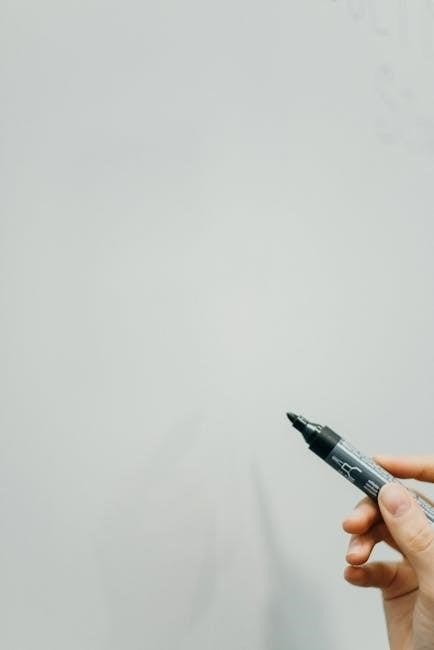Da Vinci Bridge: Instructions and Construction
This section details constructing Da Vinci’s ingenious self-supporting bridge, which requires no fasteners. Diagrams and instructions provide deeper insight into the bridge’s mathematical foundations, allowing enthusiasts to explore its design.
Overview of the Da Vinci Bridge
The Da Vinci Bridge, conceived by Leonardo da Vinci, stands as a testament to ingenuity in engineering. This self-supporting bridge is designed to be constructed without the use of nails, ropes, glue, or any conventional fasteners. Instead, it relies solely on the principles of friction and gravity to maintain its structural integrity.
Da Vinci’s simplest bridge idea was arguably the most ingenious. The bridge is built using interlocking sticks or beams. Detailed diagrams and instructions are available, providing a deeper look into the mathematical foundations of the bridge. These resources are invaluable for enthusiasts seeking to understand the physics and engineering principles at play.
The bridge can be constructed in various sizes, from miniature models using popsicle sticks to human-sized versions using wooden beams; The instructions guide builders through each step, ensuring stability and symmetry in the final structure. The bridge’s unique design has fascinated students and engineers, showcasing Da Vinci’s ability to combine art and science.
Principles of Self-Supporting Structure
The Da Vinci Bridge’s self-supporting structure operates on fundamental physics principles, primarily relying on balanced forces and friction. Unlike conventional bridges that depend on external supports, the Da Vinci Bridge achieves stability through the interlocking arrangement of its components. Each stick or beam is strategically placed to distribute weight evenly, creating a stable and load-bearing structure.
The genius of the design lies in its ability to convert vertical forces into horizontal thrusts, which are then counteracted by the structure itself. This interplay of forces ensures that the bridge remains standing without any external support. The interlocking nature of the components maximizes friction between them, preventing slippage and maintaining the bridge’s integrity.
Detailed diagrams and mathematical explanations further elucidate these principles, offering enthusiasts a deeper understanding. When the bridge is correctly assembled, the weight of each element contributes to the overall stability, demonstrating Da Vinci’s innovative approach to structural engineering. This design showcases how simple physics can create complex and self-sustaining structures.

Materials Required
Constructing a Da Vinci Bridge requires specific materials, varying based on scale. A miniature model utilizes popsicle sticks, while a human-sized bridge necessitates longer beams and supporting sticks for structural integrity and safety.
For a Miniature Model (Popsicle Sticks)
To embark on creating a miniature Da Vinci bridge, popsicle sticks are your primary resource. These readily available and inexpensive materials are perfect for demonstrating the core principles of the self-supporting structure. You’ll need a sufficient quantity of sticks, typically around 24-30, depending on the desired length and height of your model.
Ensure the popsicle sticks are uniform in size and relatively straight to ensure stability in your construction. Before starting, it’s helpful to lay out your sticks and visualize the structure, referencing diagrams or instructions. This will aid in understanding the interlocking pattern.
While no additional tools are strictly necessary, having a flat surface to work on is beneficial. Also, consider having a ruler or measuring tape to maintain symmetry. A visual guide, such as a printed diagram, can be extremely helpful in following the step-by-step instructions for weaving and interlocking the sticks.
For a Human-Sized Bridge (Beams and Sticks)
Constructing a human-sized Da Vinci bridge requires sturdier materials. Beams, approximately 1.8 meters long, and sticks, around 1 meter long, are essential. Prioritize safety; use durable wood capable of bearing weight. If beams differ slightly in size, arrange them in matching pairs for balanced support.
A soft landing surface is strongly advisable beneath the bridge during construction and testing. This precaution mitigates potential injuries from falls. Gather necessary tools: a saw for adjustments, measuring tape for precision, and possibly sandpaper for smoothing rough edges.
Ensure the sticks are straight and free from significant defects. Clear a spacious, level area for assembly. Diagrams or printable instructions become invaluable references, guiding the complex interlocking process. Emphasize careful measurements and precise placement, as these directly impact the bridge’s structural integrity and load-bearing capacity. Remember, safety first!

Step-by-Step Construction Guide
This guide outlines the process of building a Da Vinci bridge, involving laying the foundation, adding height and stability, and interlocking the sticks. Follow these steps for structural success.
Laying the Foundation
The foundation of the Da Vinci bridge is crucial for its stability. Begin by selecting a flat surface to ensure an even distribution of weight. Take two sticks and crisscross them at their centers. This initial intersection forms the base upon which the entire structure will rest. Ensure the sticks are aligned symmetrically to maintain balance.
Next, add more sticks underneath the center of the crisscrossed pair, creating layers of support. These additional sticks enhance the foundation’s strength and prevent it from collapsing under its own weight. Focus on maintaining a consistent pattern as you add more sticks, ensuring each one is properly aligned and contributes to the overall stability.
The foundation should gradually expand outwards, creating a wider base that can accommodate the increasing weight of the bridge as it rises. Pay close attention to the angles at which the sticks intersect, as this will influence the bridge’s load-bearing capacity. A well-laid foundation is essential for the successful construction of the Da Vinci bridge, providing a solid and dependable starting point for the rest of the structure.
Adding Height and Stability
Once the foundation is laid, the next step is to add height and stability to the Da Vinci bridge. This involves sliding sticks under the center sticks of the foundation, creating a layered effect. As you add these sticks, ensure they are evenly spaced and aligned to maintain balance. This process builds the bridge upwards while reinforcing its structural integrity.
Repeat this step on the opposite side of the foundation to ensure symmetry. Symmetry is crucial for distributing weight evenly and preventing the bridge from tilting or collapsing. Carefully position each stick, making sure it interlocks with the existing structure to provide maximum support.
With each layer of sticks, the bridge gains both height and stability. The interlocking design, combined with the forces of friction and gravity, holds the structure together without the need for any fasteners. This ingenious method of construction allows the bridge to support significant weight while remaining remarkably stable. Continue adding layers, alternating sides to maintain balance, until the desired height and stability are achieved.
Weaving and Interlocking Sticks
The core of Da Vinci’s bridge lies in the weaving and interlocking of sticks, creating a self-supporting structure that defies conventional construction methods. This technique involves strategically placing sticks to create a network of interconnected elements. The key is to weave each stick over and under adjacent sticks, forming a tight and secure bond. As the sticks interlock, they create a stable platform capable of bearing substantial loads.
This weaving process distributes weight evenly throughout the structure, minimizing stress on any single point. Each stick contributes to the overall stability, working in harmony with the others to create a resilient bridge. The interlocking design also enhances friction between the sticks, further strengthening the structure.
The weaving pattern can be varied to achieve different structural properties. Experiment with different arrangements to optimize the bridge’s strength and stability. The more intricate the weaving, the stronger the bridge becomes. By carefully interlocking each stick, you transform a collection of individual components into a cohesive and load-bearing structure. The final result is a testament to Da Vinci’s ingenuity, showcasing the power of simple materials combined with clever engineering.

Variations and Adaptations
Explore diverse Da Vinci bridge adaptations, including household items and 3D-printable options. Learn to construct the bridge using readily available resources, adapting the design for different materials and environments.
Using Household Items
Embark on a creative endeavor by constructing a Da Vinci bridge utilizing common household items. This variation encourages resourcefulness and demonstrates the bridge’s adaptability. Instead of traditional beams and sticks, explore options such as cardboard tubes, sturdy books, or even tightly rolled newspapers; The key is to ensure that the chosen materials possess sufficient rigidity to support the structure’s weight.
Experiment with varying lengths and thicknesses to observe their impact on the bridge’s stability. Detailed diagrams and instructions remain applicable, guiding the arrangement of household items to replicate the self-supporting principle. This approach provides an accessible introduction to engineering concepts and fosters problem-solving skills.
Consider decorating the completed bridge with paint, markers, or other decorative elements to enhance its aesthetic appeal. The use of household items not only simplifies the construction process but also promotes sustainability by repurposing existing materials. Remember safety precautions and have fun building the bridge.
3D Printable Options
Venture into the realm of modern technology by exploring 3D printable Da Vinci bridge components. This approach offers precision and customization, allowing for intricate designs and variations. Numerous online platforms provide downloadable 3D models of Da Vinci bridge elements, optimized for printing with various materials.
Utilize these models to produce individual sticks or beams, ensuring consistent dimensions and interlocking capabilities. The use of 3D printing enables experimentation with different materials, such as durable plastics or even specialized composites, to enhance the bridge’s structural integrity. Explore the possibility of creating miniature versions or scaled-up models, depending on your printer’s capacity.
Detailed diagrams and instructions remain relevant, guiding the assembly of the 3D printed components. Consider incorporating unique design elements, such as decorative patterns or personalized engravings, to customize your Da Vinci bridge. This option provides an engaging blend of historical engineering and cutting-edge technology.
Remember to research suitable printing settings and material properties to achieve optimal results.

The Physics Behind the Bridge
The Da Vinci bridge is a testament to ingenious engineering, relying on fundamental physics principles. Its self-supporting structure defies conventional construction methods, eschewing nails, glue, or fasteners.
The bridge’s stability stems from a delicate balance of compression and friction. Each component exerts a compressive force on adjacent pieces, creating a network of interlocking supports. Gravity plays a crucial role, pulling the elements downwards and increasing frictional forces between them.
The angled arrangement of the sticks or beams directs forces inward, towards the bridge’s center. This inward force counteracts the outward forces of gravity, preventing the structure from collapsing. Friction between the overlapping surfaces further enhances stability, resisting slippage and maintaining the bridge’s integrity.
The Da Vinci bridge exemplifies the power of simple physics principles when applied with creativity and precision. Understanding these underlying principles allows for informed design modifications and optimizations. Exploring diagrams and instructions provides further insight into the bridge’s structural behavior.
This project is an excellent demonstration of physics in action.
